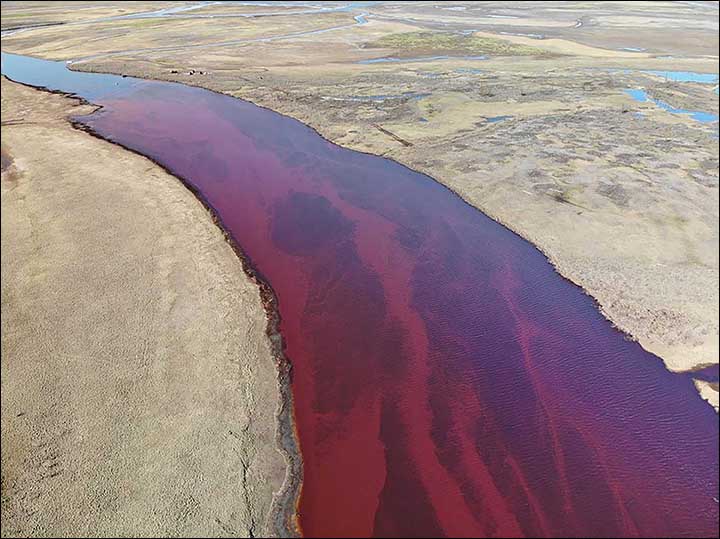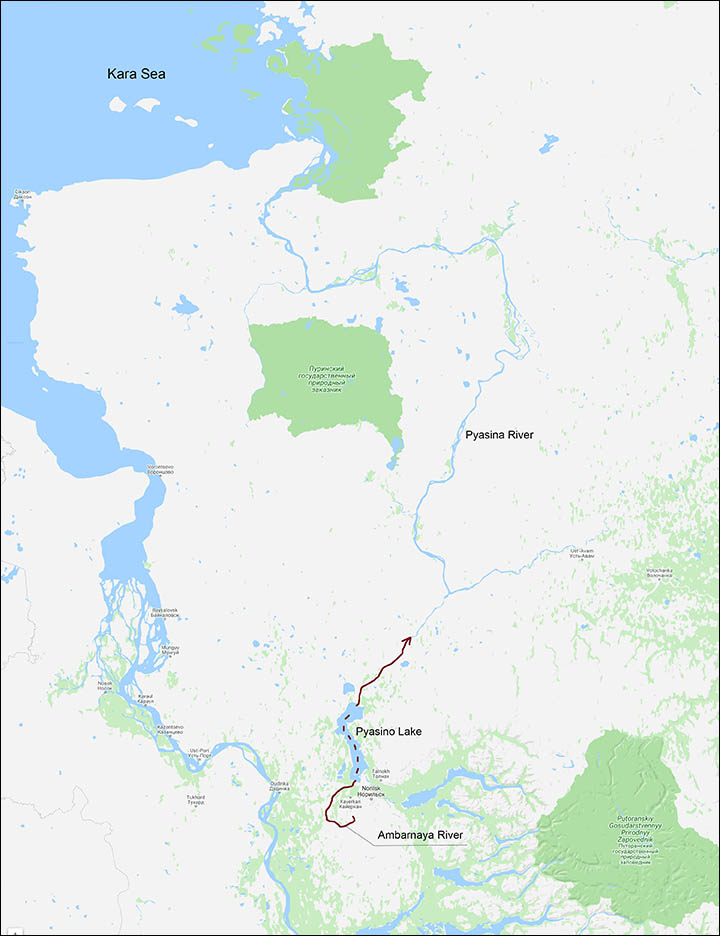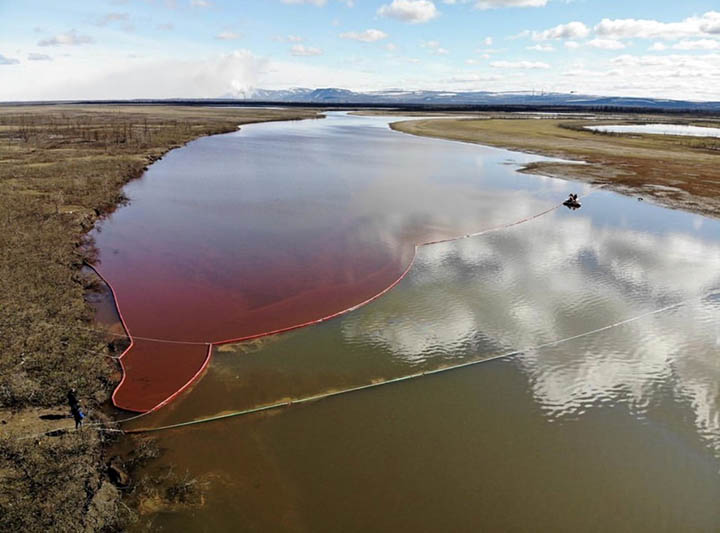
A huge flow of diesel has reached stunning Lake Pyasino in the Arctic after the recent accident at a thermal power plant near Norilsk, it is believed. This indicates the failure of initial attempts to contain the toxic pollution, and with the lake linked by the Pyasina River to the Kara Sea there are now fears much worse is to come. A grim Krasnoyarsk governor Alexander Uss said: ‘The fuel has got into Lake Pyasino. This is a beautiful lake about 70 kilometres long.‘But it’s impossible to predict how it will bear this brunt now. At the moment, it’s important to prevent spilled fuel from pouring into the Pyasina River, which flows farther to the north.‘I think that it will be possible.’


On 29 May, diesel leaked into the Ambarnaya and Daldykan rivers from a fuel tank weakened by permafrost thawing at Power Plant No. 3 of Norilsk-Taymyr Energy Company (NTEC), which is part of Norilsk Nickel and provides electricity for the Norilsk industrial district.The quantity fuel released mainly into the river system above the Arctic Circle would fit into 350 train cisterns.
The lake under immediate threat is of glacial origin and is some 20 km from Norilsk. The only river flowing out of it – the Pyasina passes through the Great Arctic State Nature Reserve and flows into the Kara Sea, part of the Arctic Ocean. Norilsk Nickel – the giant company ultimately behind the leak – strenuously denies both that diesel has reached the lake or that there is any threat to the Kara Sea.
Closer to the spill site in Bezymyanny spring analysis shows 1,100 times the
maximum concentration limits.
Wind the clock back, and late on 29 May, Vasily Ryabinin, a regional inspector of state ecological watchdog Rosprirodnadzor was on his way home when he received a call from his chief. ‘He told me about an emergency, a fuel leak from a tank, and he asked me to go there and check what had happened,’ said Ryabinin. ‘I told him that he was very close to the place of the leak, since he was on the Daldykan, so he could be very fast to this place. ‘He went there, called me, and told me that he was not allowed there. He came back to the office, we discussed the situation, and decided we must monitor it, we cannot just leave it as it is.‘We have no special transport in our department, so I asked my wife to be our driver. ‘We passed our kids to our friends and rushed there. ‘When we arrived at the accident site, we were not allowed there by the security guards of TPP. We saw a police car there, approached it, reported that we are from Rosprirodnadzor and must check the emergency scene.’My chief showed them documents, but they did not allow us to enter, saying it was private territory.’
This sounds incredible but it was true: the state’s own local ecological watchdog officials were not permitted to visit the scene of an environmental emergency of huge proportions.
‘We drove further, and stopped not so far from the railway bridge across the Daldykan River.‘About 500 metres from the river we felt a strong smell of diesel.’‘It was just a mountainous river of diesel, the smell of the diesel was very strong. I felt like I was drunk’.
Dmitry Klokov, from the Federal Agency of Fisheries, told Kommersant newspaper that its monitoring suggests the bulk of leaked diesel fuel went under the barrage booms on the Ambarnaya and is now located in Pyasino.
Pavel Kochkarev, director of the Central Siberian Reserve, told Prospekt Mira newspaper of the appalling threat to wildlife. ’20,000 tons of diesel fuel that leaked into the rivers is a disaster in itself,’ he said. ‘These are 350 wagons (of fuel) that rushed along the rivers with terrible speed, and some significant part of the fuel fell into Lake Pyasino.‘From here it flows the Pyasina River, along which are the main pastures of wild reindeer. Geese coming from the south nest here, including many Red Book birds, such as the Red-throated Goose. ‘Now in the north, due to the high temperature, there is an early flood – that is, huge areas are flooded with water, through which diesel fuel will spread. Water will then decrease, and diesel fuel, as a light agent, will settle on all grassy and shrubby vegetation along the banks of Pyasina, where deer eat and birds nest. ‘In addition, part of Pyasina is still iced over. The ice will be saturated with diesel fuel and then carry it further. ‘We still cannot say what consequences this will lead to. Now there will be summer field work, a lot of scientists will leave for the place – and probably, closer to September, something can be said.‘But so far the forecast is not good.
Local activists like Ruslan Abdulaev say they are being kept away from key sites in this saga.‘The place of the fuel spill is strictly protected from prying eyes, there’s no way to get there.‘We, as volunteers, expressed a desire to help in the elimination of emergencies, and at the same time assess the scale of the environmental disaster on the spot. ‘This definitely needs public control.’
There is a gloomy assessment, too, from Alexander Kolotov, head of Rivers without Boundaries. ‘We often hear the official slogans about the development of the Arctic,’ he said. ‘The current environmental disaster is actually a real stress test for the region, which shows that we are absolutely not ready for this. The true circumstances of how 20,000 tons of diesel could leak into the river remain a mystery. The fact is that around tanks for petroleum products there is always a special protective platform with sides, which should contain the entire volume of fuel during its spill. ‘It turns out that in this case there were holes in the fence or a salvo breakthrough was of such force that it destroyed the protective walls.WAS IT THAWED PERMAFROST, NEGLIGENCE – OR BOTH? ‘It is ridiculous to explain what happened to the thawed soil due to an abnormally warm weather. This is not force majeure and not an emergency, but a completely predictable thing that you could think about in advance. Such things should be identified at a routine technical inspection.
‘It is also striking that the information reached the centre only two days later, that is, the warning system does not work at all. At the same time, local ecologists already had satellite images showing the scale of the disaster. ‘But the time factor plays a huge role. ‘The main problem is that the leak was not of oil itself, but of the product of its processing – diesel. ‘Booms will not be able to completely stop the diesel, part of the oil product will still go beyond and then settle to the bottom. For complete cleaning, it is necessary to completely remove the soil from the bottom of water bodies. So far it is about at least collecting all the spots from the surface.
‘Now there are problems with this, as there are not enough tanks to drain pumped oil products. ‘And it’s problematic to quickly deliver them to the tundra. ‘It is clear that with this attitude to ecology, the development of the Arctic will lead to the fact that we simply will not preserve the nature of the region.’
Meanwhile, the Emergencies Ministry is stressing the effectiveness of work to remedy the leakage.The state has assessed that 6,000 tons of diesel seeped into the ground – which is now being cleared. Another 15,000 ended up in nearby waterways.
The director of the power plant Vyacheslav Starostin has become the fall guy for the scandal, and has been charged with violating environmental protection rules, said the Russian Investigative Committee.
Text By Anna Liesowska . Siberian Times

